2022 KIA RIO Page 6
[x] Cancel search: Page 6Page 27 of 528
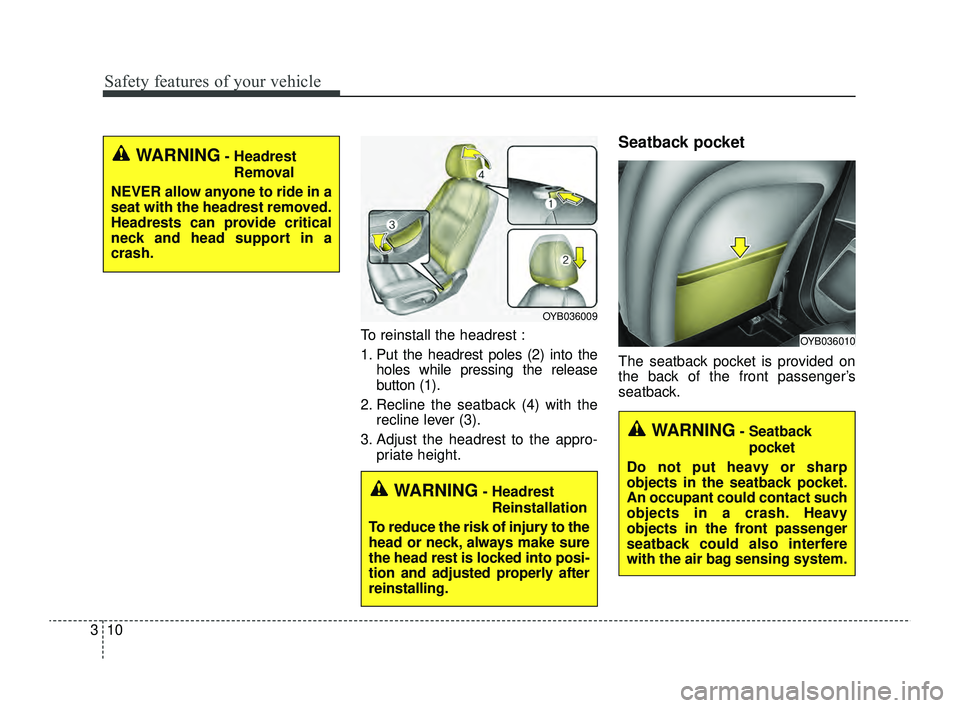
Safety features of your vehicle
10
3
To reinstall the headrest :
1. Put the headrest poles (2) into the
holes while pressing the release
button (1).
2. Recline the seatback (4) with the recline lever (3).
3. Adjust the headrest to the appro- priate height.
Seatback pocket
The seatback pocket is provided on
the back of the front passenger’s
seatback.
WARNING- Seatback
pocket
Do not put heavy or sharp
objects in the seatback pocket.
An occupant could contact such
objects in a crash. Heavy
objects in the front passenger
seatback could also interfere
with the air bag sensing system.
OYB036010
WARNING- Headrest Reinstallation
To reduce the risk of injury to the
head or neck, always make sure
the head rest is locked into posi-
tion and adjusted properly after
reinstalling.
OYB036009
WARNING- Headrest Removal
NEVER allow anyone to ride in a
seat with the headrest removed.
Headrests can provide critical
neck and head support in a
crash.
SC PE USA 3.QXP 8/23/2021 5:37 PM Page 10
Page 28 of 528
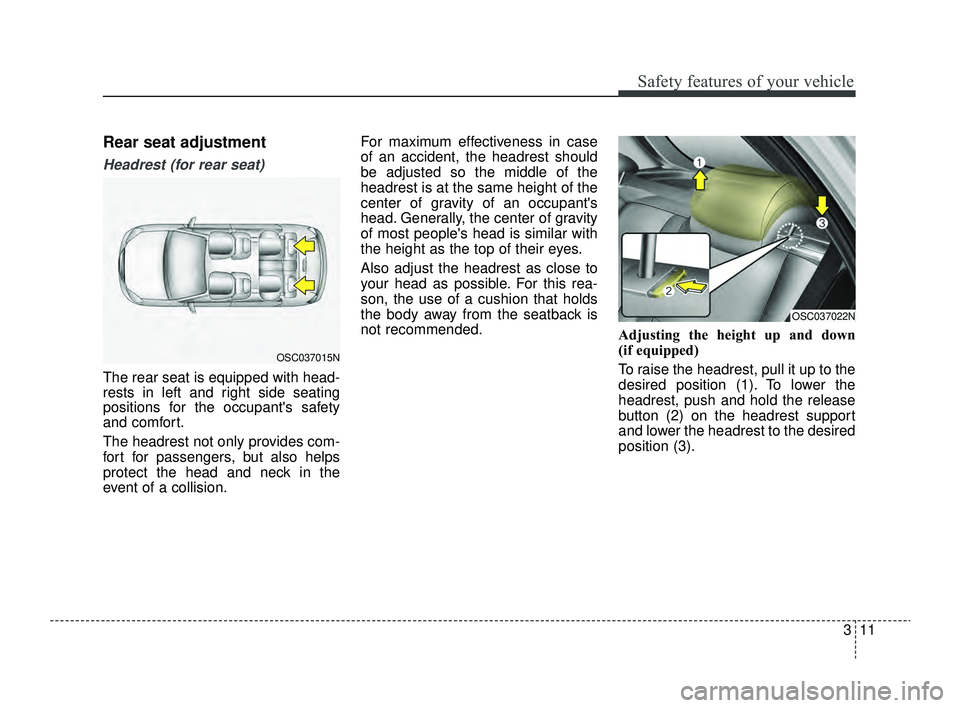
311
Safety features of your vehicle
Rear seat adjustment
Headrest (for rear seat)
The rear seat is equipped with head-
rests in left and right side seating
positions for the occupant's safety
and comfort.
The headrest not only provides com-
fort for passengers, but also helps
protect the head and neck in the
event of a collision.For maximum effectiveness in case
of an accident, the headrest should
be adjusted so the middle of the
headrest is at the same height of the
center of gravity of an occupant's
head. Generally, the center of gravity
of most people's head is similar with
the height as the top of their eyes.
Also adjust the headrest as close to
your head as possible. For this rea-
son, the use of a cushion that holds
the body away from the seatback is
not recommended.
Adjusting the height up and down
(if equipped)
To raise the headrest, pull it up to the
desired position (1). To lower the
headrest, push and hold the release
button (2) on the headrest support
and lower the headrest to the desired
position (3).
OSC037022N
OSC037015N
SC PE USA 3.QXP 8/23/2021 5:37 PM Page 11
Page 29 of 528
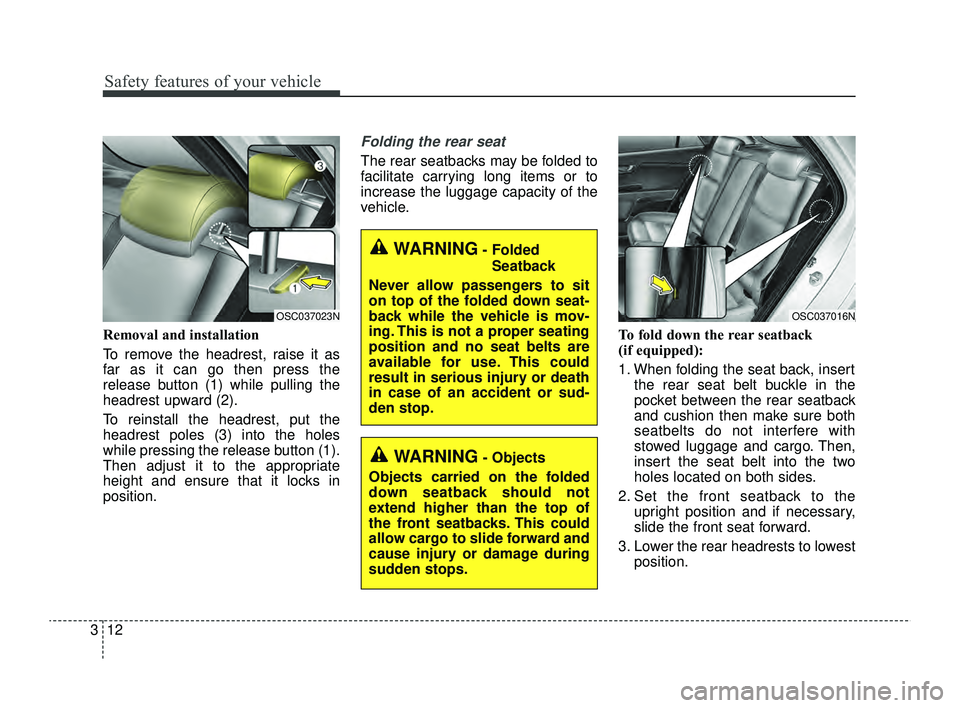
Safety features of your vehicle
12
3
Removal and installation
To remove the headrest, raise it as
far as it can go then press the
release button (1) while pulling the
headrest upward (2).
To reinstall the headrest, put the
headrest poles (3) into the holes
while pressing the release button (1).
Then adjust it to the appropriate
height and ensure that it locks in
position.
Folding the rear seat
The rear seatbacks may be folded to
facilitate carrying long items or to
increase the luggage capacity of the
vehicle.
To fold down the rear seatback
(if equipped):
1. When folding the seat back, insertthe rear seat belt buckle in the
pocket between the rear seatback
and cushion then make sure both
seatbelts do not interfere with
stowed luggage and cargo. Then,
insert the seat belt into the two
holes located on both sides.
2. Set the front seatback to the upright position and if necessary,
slide the front seat forward.
3. Lower the rear headrests to lowest position.
WARNING- Folded
Seatback
Never allow passengers to sit
on top of the folded down seat-
back while the vehicle is mov-
ing. This is not a proper seating
position and no seat belts are
available for use. This could
result in serious injury or death
in case of an accident or sud-
den stop.
WARNING- Objects
Objects carried on the folded
down seatback should not
extend higher than the top of
the front seatbacks. This could
allow cargo to slide forward and
cause injury or damage during
sudden stops.
OSC037016NOSC037023N
SC PE USA 3.QXP 8/23/2021 5:37 PM Page 12
Page 30 of 528
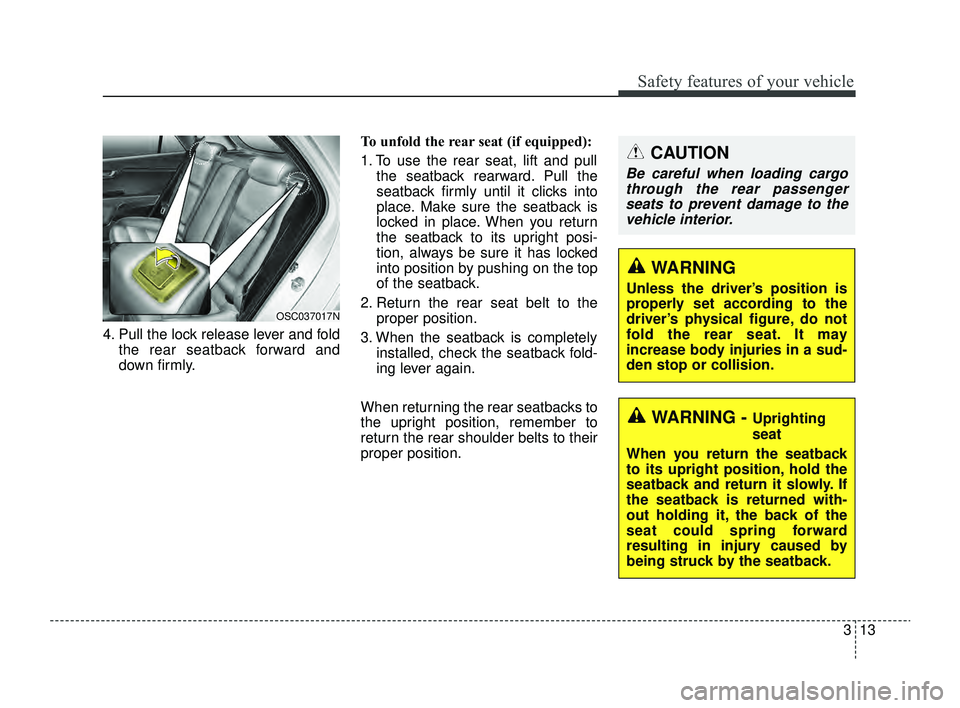
313
Safety features of your vehicle
4. Pull the lock release lever and foldthe rear seatback forward and
down firmly. To unfold the rear seat (if equipped):
1. To use the rear seat, lift and pull
the seatback rearward. Pull the
seatback firmly until it clicks into
place. Make sure the seatback is
locked in place. When you return
the seatback to its upright posi-
tion, always be sure it has locked
into position by pushing on the top
of the seatback.
2. Return the rear seat belt to the proper position.
3. When the seatback is completely installed, check the seatback fold-
ing lever again.
When returning the rear seatbacks to
the upright position, remember to
return the rear shoulder belts to their
proper position.
OSC037017N
CAUTION
Be careful when loading cargo through the rear passengerseats to prevent damage to thevehicle interior.
WARNING
Unless the driver’s position is
properly set according to the
driver’s physical figure, do not
fold the rear seat. It may
increase body injuries in a sud-
den stop or collision.
WARNING - Uprighting
seat
When you return the seatback
to its upright position, hold the
seatback and return it slowly. If
the seatback is returned with-
out holding it, the back of the
seat could spring forward
resulting in injury caused by
being struck by the seatback.
SC PE USA 3.QXP 8/23/2021 5:37 PM Page 13
Page 31 of 528
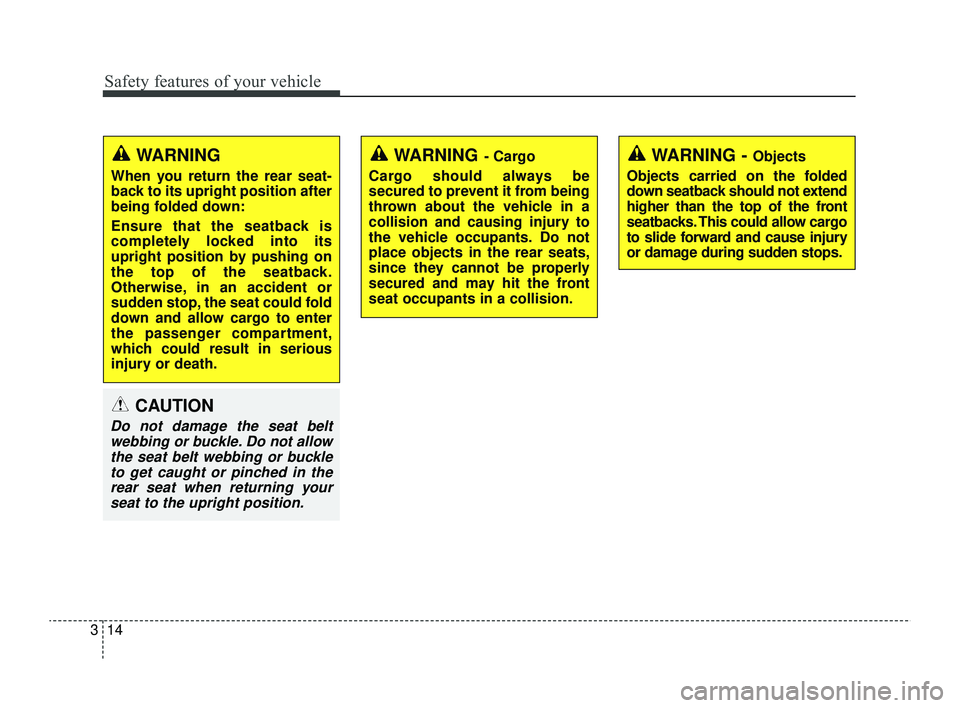
Safety features of your vehicle
14
3
WARNING - Objects
Objects carried on the folded
down seatback should not extend
higher than the top of the front
seatbacks. This could allow cargo
to slide forward and cause injury
or damage during sudden stops.WARNING- Cargo
Cargo should always be
secured to prevent it from being
thrown about the vehicle in a
collision and causing injury to
the vehicle occupants. Do not
place objects in the rear seats,
since they cannot be properly
secured and may hit the front
seat occupants in a collision.WARNING
When you return the rear seat-
back to its upright position after
being folded down:
Ensure that the seatback is
completely locked into its
upright position by pushing on
the top of the seatback.
Otherwise, in an accident or
sudden stop, the seat could fold
down and allow cargo to enter
the passenger compartment,
which could result in serious
injury or death.
CAUTION
Do not damage the seat belt webbing or buckle. Do not allowthe seat belt webbing or buckleto get caught or pinched in therear seat when returning yourseat to the upright position.
SC PE USA 3.QXP 8/23/2021 5:37 PM Page 14
Page 32 of 528
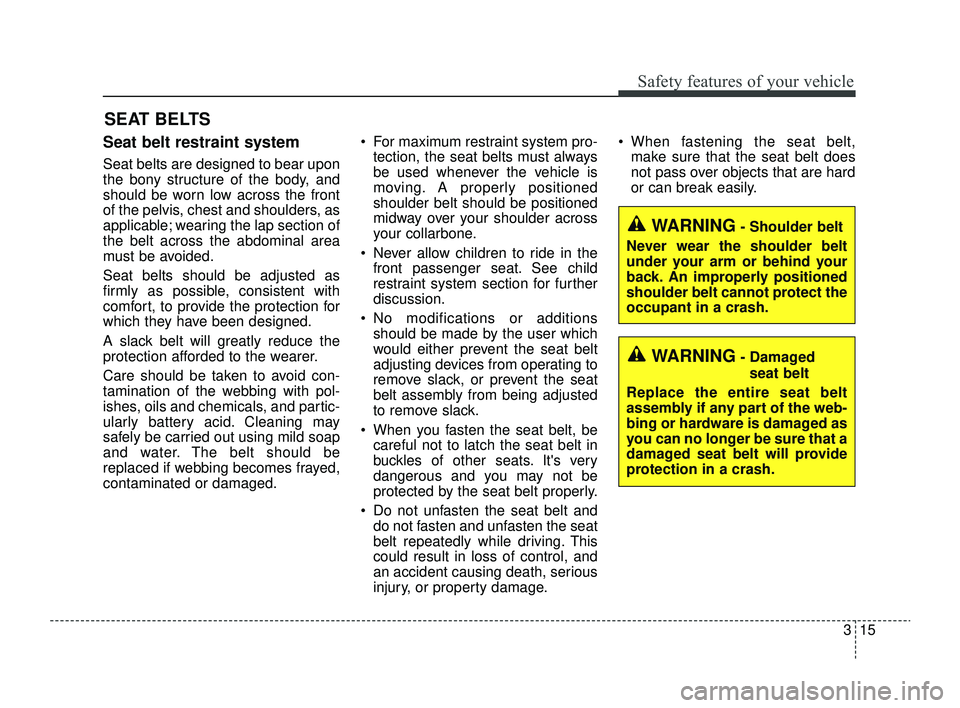
315
Safety features of your vehicle
Seat belt restraint system
Seat belts are designed to bear upon
the bony structure of the body, and
should be worn low across the front
of the pelvis, chest and shoulders, as
applicable; wearing the lap section of
the belt across the abdominal area
must be avoided.
Seat belts should be adjusted as
firmly as possible, consistent with
comfort, to provide the protection for
which they have been designed.
A slack belt will greatly reduce the
protection afforded to the wearer.
Care should be taken to avoid con-
tamination of the webbing with pol-
ishes, oils and chemicals, and partic-
ularly battery acid. Cleaning may
safely be carried out using mild soap
and water. The belt should be
replaced if webbing becomes frayed,
contaminated or damaged. For maximum restraint system pro-
tection, the seat belts must always
be used whenever the vehicle is
moving. A properly positioned
shoulder belt should be positioned
midway over your shoulder across
your collarbone.
Never allow children to ride in the front passenger seat. See child
restraint system section for further
discussion.
No modifications or additions should be made by the user which
would either prevent the seat belt
adjusting devices from operating to
remove slack, or prevent the seat
belt assembly from being adjusted
to remove slack.
When you fasten the seat belt, be careful not to latch the seat belt in
buckles of other seats. It's very
dangerous and you may not be
protected by the seat belt properly.
Do not unfasten the seat belt and do not fasten and unfasten the seat
belt repeatedly while driving. This
could result in loss of control, and
an accident causing death, serious
injury, or property damage. When fastening the seat belt,
make sure that the seat belt does
not pass over objects that are hard
or can break easily.
SEAT BELTS
WARNING- Shoulder belt
Never wear the shoulder belt
under your arm or behind your
back. An improperly positioned
shoulder belt cannot protect the
occupant in a crash.
WARNING- Damaged seat belt
Replace the entire seat belt
assembly if any part of the web-
bing or hardware is damaged as
you can no longer be sure that a
damaged seat belt will provide
protection in a crash.
SC PE USA 3.QXP 8/23/2021 5:37 PM Page 15
Page 33 of 528

Safety features of your vehicle
16
3
Driver’s seat belt warning
As a reminder to the driver, the
Driver’s seat belt warning lights will
illuminate for approximately 6 sec-
onds each time you turn the ignition
switch or ENGINE START/STOP but-
ton ON regardless of belt fastening.
If the seatbelt is not fastened, the
warning chime will sound for about 6
seconds. If you start to drive without
the seat belt fastened or you unfas-
ten the seat belt when you drive
under 12 mph (20 km/h) or stop, the
corresponding warning light will illu-
minate. If you start to drive without the seat
belt fastened or you unfasten the
seat belt when you drive 12 mph (20
km/h) and faster, the warning light
will blink and warning chime will
sound for approximately 100 sec-
onds.
When the seat belt is unfastened
during driving, the warning light will
illuminate when the speed is under
12 mph (20 km/h).
When the speed is 12 mph (20 km/h)
and faster, the warning light will blink
and warning chime will sound for
approximately 100 seconds.
WARNING- Twisted seat
belt
Make sure your seat belt is not
twisted when worn. A twisted
seat belt may not properly pro-
tect you in an accident and
could even cut into your body.
WARNING- Seat belt buckle
Do not allow foreign material
(gum, crumbs, coins, etc.) to
obstruct the seat belt buckle.
This may prevent the seat belt
from fastening securely.1GQA2083
SC PE USA 3.QXP 8/23/2021 5:37 PM Page 16
Page 34 of 528
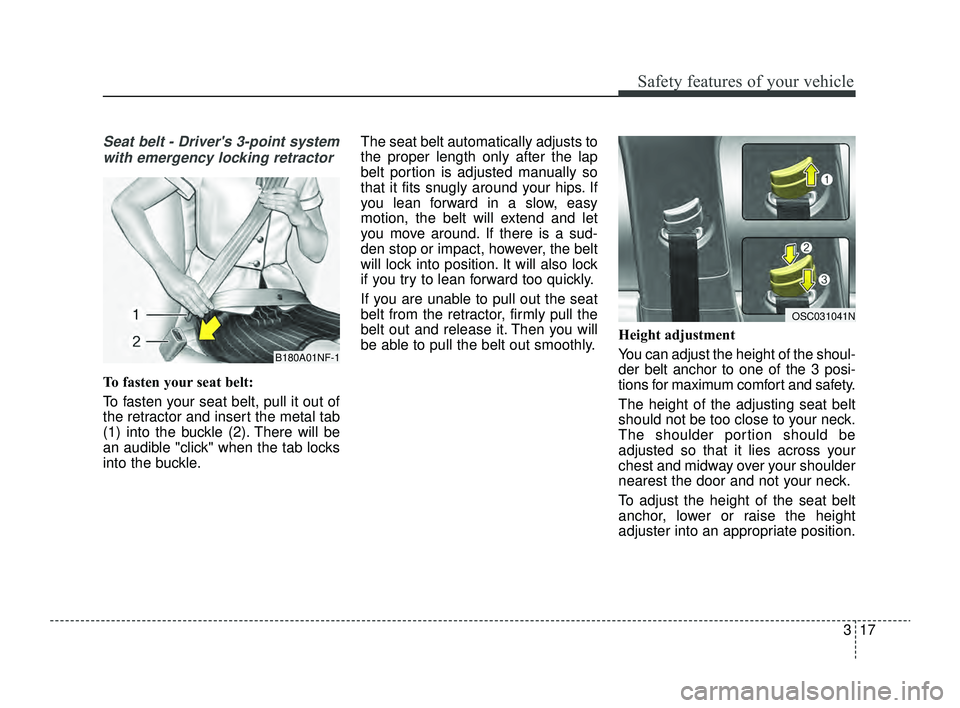
317
Safety features of your vehicle
Seat belt - Driver's 3-point systemwith emergency locking retractor
To fasten your seat belt:
To fasten your seat belt, pull it out of
the retractor and insert the metal tab
(1) into the buckle (2). There will be
an audible "click" when the tab locks
into the buckle. The seat belt automatically adjusts to
the proper length only after the lap
belt portion is adjusted manually so
that it fits snugly around your hips. If
you lean forward in a slow, easy
motion, the belt will extend and let
you move around. If there is a sud-
den stop or impact, however, the belt
will lock into position. It will also lock
if you try to lean forward too quickly.
If you are unable to pull out the seat
belt from the retractor, firmly pull the
belt out and release it. Then you will
be able to pull the belt out smoothly.
Height adjustment
You can adjust the height of the shoul-
der belt anchor to one of the 3 posi-
tions for maximum comfort and safety.
The height of the adjusting seat belt
should not be too close to your neck.
The shoulder portion should be
adjusted so that it lies across your
chest and midway over your shoulder
nearest the door and not your neck.
To adjust the height of the seat belt
anchor, lower or raise the height
adjuster into an appropriate position.
OSC031041N
B180A01NF-1
SC PE USA 3.QXP 8/23/2021 5:37 PM Page 17